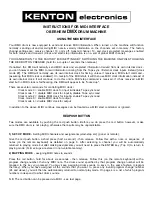
MIDI Connections
When connected to other MIDI devices, the SPD-20 can be used in a wide variety of musically creative
ways. For example, it can be connected to a sequencer as a pad controller for realtime input, and its on-
board sound generator can be layered with external sound modules. Other applications include using a
sequencer to automatically select SPD-20 Patches, or to store SPD-20 data in a sequencer or other MIDI
Bulk storage device.
Example of one way to connect when using the SPD-20 to control an external sound
module
fig.64
About MIDI
MIDI is an acronym for “Musical Instrument Digital Interface,” and is a standard by which electronic
musical Instruments and computers can exchange musical data. The SPD-20 conforms to the MIDI spec-
ification and can be connected to other devices to either control, or be controlled.
How MIDI Data is Sent and Received
First, we will briefly explain how MIDI data is sent and received.
MIDI connectors
MIDI data is sent and received through the following connectors. Use a MIDI cable to connectors these
connectors to other devices.
fig.65
MIDI IN:
receives data from other MIDI devices
MIDI OUT:
transmits data to other MIDI devices
MIDI THRU:
re-transmits the data received via MIDI IN
The SPD-20 does not have a MIDI THRU connector.
It is possible to connect (“daisy chain”) several MIDI devices
using the MIDI THRU connectors, but you should keep the
total length of MIDI cables within 10 meters, to prevent possible
reception errors.
AC adaptor
L I N E I N
L
R
Audio Equipment
(Stereo Set)
Sampler
SPD-20
MIDI IN
MIDI OUT
NOTE
CHAPTER 4 Connecting MIDI Devices
57
1
2
3
4
5

































